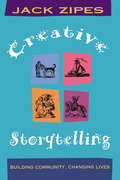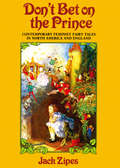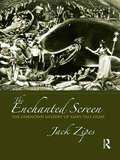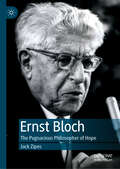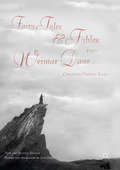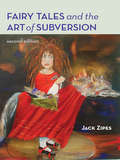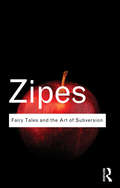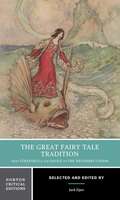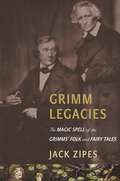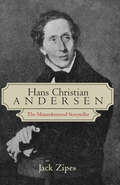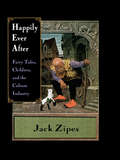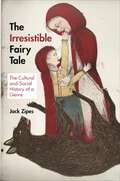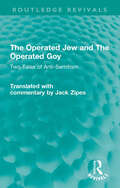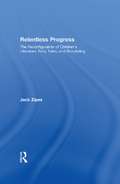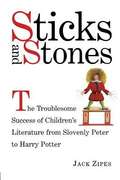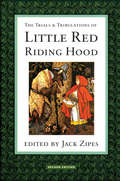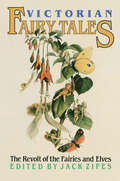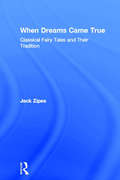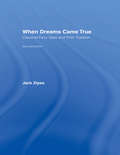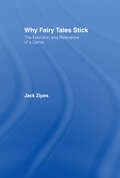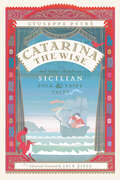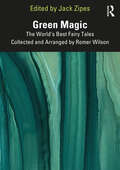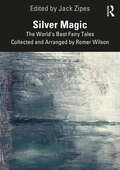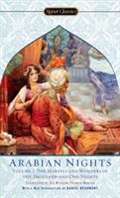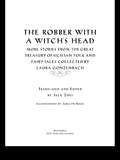- Table View
- List View
Creative Storytelling: Building Community/Changing Lives
by Jack ZipesJack Zipes has reinvigorated storytelling as a successful and engaging tool for teachers and professional storytellers. Encouraging storytellers, librarians, and schoolteachers to be active in this magical process, Zipes proposes an interactive storytelling that creates and strengthens a sense of community for students, teachers and parents while extolling storytelling as animation, subversion, and self-discovery.
Don't Bet on the Prince: Contemporary Feminist Fairy Tales in North America and England
by Jack ZipesFirst published in 1987. Routledge is an imprint of Taylor & Francis, an informa company.
The Enchanted Screen: The Unknown History of Fairy-Tale Films
by Jack ZipesThe Enchanted Screen: The Unknown History of Fairy-Tale Films offers readers a long overdue, comprehensive look at the rich history of fairy tales and their influence on film, complete with the inclusion of an extensive filmography compiled by the author. With this book, Jack Zipes not only looks at the extensive, illustrious life of fairy tales and cinema, but he also reminds us that, decades before Walt Disney made his mark on the genre, fairy tales were central to the birth of cinema as a medium, as they offered cheap, copyright-free material that could easily engage audiences not only though their familiarity but also through their dazzling special effects. Since the story of fairy tales on film stretches far beyond Disney, this book, therefore, discusses a broad range of films silent, English and non-English, animation, live-action, puppetry, woodcut, montage (Jim Henson), cartoon, and digital. Zipes, thus, gives his readers an in depth look into the special relationship between fairy tales and cinema, and guides us through this vast array of films by tracing the adaptations of major fairy tales like "Little Red Riding Hood," "Cinderella," "Snow White," "Peter Pan," and many more, from their earliest cinematic appearances to today. Full of insight into some of our most beloved films and stories, and boldly illustrated with numerous film stills, The Enchanted Screen, is essential reading for film buffs and fans of the fairy tale alike.
Ernst Bloch: The Pugnacious Philosopher of Hope
by Jack ZipesThis book provides a comprehensive introduction to and overview of the life and philosophy of Ernst Bloch. Bloch has had a strange fate in the English-speaking world. He wrote his famous three-volume opus, The Principle of Hope, while living in exile in the United States from 1938 to 1940. It was first published, however, in East Germany in the 1950s after he had returned to Europe and became a professor of philosophy at the University of Leipzig. Gradually, his other numerous works became better known and widespread in Europe and scholars in the US and UK started to take note of his works. Yet, he has still remained a somewhat neglected figure in the humanities. While this book does not set out to entirely rectify this neglect, it does offer readers an introduction to Bloch’s works and the opportunity to understand more about the importance of utopian thought. Through an exploration of some of Bloch’s more controversial communist leanings and relationship to the Soviet Union, a study of Bloch’s utopian quest, and even a comparison with J. R. R. Tolkien, this comprehensive study demonstrates just how interesting a figure Ernst Bloch really was, and how his philosophy of hope has laid the basis for secular humanism.
Fairy Tales and Fables from Weimar Days
by Jack ZipesThis book is a collection of traditional German fairy tales and fables, deliberately transformed into utopian narratives and social commentary by political activists in the Weimar Republic (1919-1933). Against a backdrop of financial and political instability, widespread homelessness, and the reformation of public institutions, numerous gifted writers such as Berta Lask, Kurt Schwitters, Hermynia zur Mühlen, Oskar Maria Graf, Bruno Schönlank, and Joachim Ringelnatz responded to the need for hope among the common people by creating fairy tales and fables that offered a new and critical vision of social conditions. Though many of their tales deal with the grim situation of common people and their apparent helplessness, they are founded on the principle of hope. This revised edition includes over 50 illustrations by contemporary international artists who reveal how similar the Weimar conditions were to the conditions in which we presently live. In this respect, the Weimar fairy tales and fables have not lost their spirit and significance.
Fairy Tales and the Art of Subversion: The Classical Genre For Children And The Process Of Civilization (Routledge Classics Ser.)
by Jack ZipesThe fairy tale may be one of the most important cultural and social influences on children's lives. But until Fairy Tales and the Art of Subversion, little attention had been paid to the ways in which the writers and collectors of tales used traditional forms and genres in order to shape children's lives – their behavior, values, and relationship to society. As Jack Zipes convincingly shows, fairy tales have always been a powerful discourse, capable of being used to shape or destabilize attitudes and behavior within culture.For this new edition, the author has revised the work throughout and added a new introduction bringing this classic title up to date.
Fairy Tales and the Art of Subversion: The Classical Genre For Children And The Process Of Civilization (Routledge Classics)
by Jack ZipesThe fairy tale is arguably one of the most important cultural and social influences on children's lives. But until the first publication of Fairy Tales and the Art of Subversion, little attention had been paid to the ways in which the writers and collectors of tales used traditional forms and genres in order to shape children's lives – their behavior, values, and relationship to society. As Jack Zipes convincingly shows in this classic work, fairy tales have always been a powerful discourse, capable of being used to shape or destabilize attitudes and behavior within culture. How and why did certain authors try to influence children or social images of children? How were fairy tales shaped by the changes in European society in the sixteenth and seventeenth centuries? Zipes examines famous writers of fairy tales such as Charles Perrault, Jacob and Wilhelm Grimm, Hans Christian Andersen and L.Frank Baum and considers the extraordinary impact of Walt Disney on the genre as a fairy tale filmmaker.
The Great Fairy Tale Tradition: From Straparola And Basile To The Brothers Grimm
by Jack ZipesThe tales―116 in all―are thematically grouped. Each grouping is introduced and annotated by Jack Zipes, the genre’s reigning expert. Twenty illustrations accompany the texts. "Criticism" includes seven important assessments of different aspects of the fairy tale tradition, written by W. G. Waters, Benedetto Croce, Lewis Seifert, Patricia Hannon, Harry Velten, Siegfried Neumann, and Jack Zipes. Brief biographies of the storytellers and a Selected Bibliography are included.
Grimm Legacies: The Magic Spell of the Grimms' Folk and Fairy Tales
by Jack ZipesIn Grimm Legacies, esteemed literary scholar Jack Zipes explores the legacy of the Brothers Grimm in Europe and North America, from the nineteenth century to the present. Zipes reveals how the Grimms came to play a pivotal and unusual role in the evolution of Western folklore and in the history of the most significant cultural genre in the world—the fairy tale.Folklorists Jacob and Wilhelm Grimm sought to discover and preserve a rich abundance of stories emanating from an oral tradition, and encouraged friends, colleagues, and strangers to gather and share these tales. As a result, hundreds of thousands of wonderful folk and fairy tales poured into books throughout Europe and have kept coming. Zipes looks at the transformation of the Grimms' tales into children's literature, the Americanization of the tales, the "Grimm" aspects of contemporary tales, and the tales' utopian impulses. He shows that the Grimms were not the first scholars to turn their attention to folk tales, but were vital in expanding readership and setting the high standards for folk-tale collecting that continue through the current era. Zipes concludes with a look at contemporary adaptations of the tales and raises questions about authenticity, target audience, and consumerism.With erudition and verve, Grimm Legacies examines the lasting universal influence of two brothers and their collected tales on today's storytelling world.
Hans Christian Andersen: The Misunderstood Storyteller
by Jack ZipesThe 2005 bicentenary of Hans Christian Andersen's birth is an opportunity to re-evaluate the achievement of one of the great figures of the fairy tale and storytelling tradition, a beloved writer famous for The Snow Queen and The Little Mermaid, The Ugly Duckling and The Red Shoes and many other now classic tales. Jack Zipes broadens our understanding of Andersen by exploring the relation of the Danish writer's work to the development of literature and of the fairy tale in particular. Based on thirty-five years of researching and writing on Andersen, this new book is a welcome reconsideration of Andersen's place and of his reception in English-speaking countries and on film.
Happily Ever After: Fairy Tales, Children, and the Culture Industry
by Jack ZipesFirst Published in 1997. Routledge is an imprint of Taylor & Francis, an informa company.
The Irresistible Fairy Tale: The Cultural and Social History of a Genre
by Jack ZipesA provocative new theory about fairy tales from one of the world's leading authoritiesIf there is one genre that has captured the imagination of people in all walks of life throughout the world, it is the fairy tale. Yet we still have great difficulty understanding how it originated, evolved, and spread—or why so many people cannot resist its appeal, no matter how it changes or what form it takes. In this book, renowned fairy-tale expert Jack Zipes presents a provocative new theory about why fairy tales were created and retold—and why they became such an indelible and infinitely adaptable part of cultures around the world.Drawing on cognitive science, evolutionary theory, anthropology, psychology, literary theory, and other fields, Zipes presents a nuanced argument about how fairy tales originated in ancient oral cultures, how they evolved through the rise of literary culture and print, and how, in our own time, they continue to change through their adaptation in an ever-growing variety of media. In making his case, Zipes considers a wide range of fascinating examples, including fairy tales told, collected, and written by women in the nineteenth century; Catherine Breillat's film adaptation of Perrault's "Bluebeard"; and contemporary fairy-tale drawings, paintings, sculptures, and photographs that critique canonical print versions.While we may never be able to fully explain fairy tales, The Irresistible Fairy Tale provides a powerful theory of how and why they evolved—and why we still use them to make meaning of our lives.
The Operated Jew and The Operated Goy: Two Tales of Anti-Semitism (Routledge Revivals)
by Jack ZipesOriginally published in English in 1991 and now reissued with a new Preface by Jack Zipes, this book presents and examines the work of two little-known writers, Oskar Panizza and Mynona (Salomo Friedlaender). In Panizza’s chilling story, The Operated Jew (1893), a turn-of-the- century Jew undergoes a series of disfiguring operations that transform him into a ‘European’. The tale mingles loathing with compassion for its title character. Thirty years later, Panizza’s tale was answered by Mynona, an urbane German Jew who turned the story’s tables in The Operated Goy (1922). In his introduction and essays, Jack Zipes explores some of the myths of modern anti-Semitic thought. He also examines parallels between the rise of anti-Semitism in Europe and the violence of Arabs and Israelis in the Middle East, issues which have an enduring relevance and are as pertinent in the 21st Century as when the book was first published.
Relentless Progress: The Reconfiguration of Children's Literature, Fairy Tales, and Storytelling
by Jack ZipesCan fairy tales subvert consumerism? Can fantasy and children's literature counter the homogenizing influence of globalization? Can storytellers retain their authenticity in the age of consumerism? These are some of the critical questions raised by Jack Zipes, the celebrated scholar of fairy tales and children's literature. In this book, Zipes argues that, despite a dangerous reconfiguration of children as consumers in the civilizing process, children's literature, fairy tales, and storytelling possess a uniquely powerful (even fantastic)capacity to resist the "relentless progress" of negative trends in culture. He also argues that these tales and stories may lose their power if they are too diluted by commercialism and merchandising. Stories have been used for centuries as a way to teach children (and adults) how to see the world, as well as their place within it. In Relentless Progress, Zipes looks at the surprising ways that stories have influenced people within contemporary culture and vice versa. Among the many topics explored here are the dumbing down of books for children, the marketing of childhood, the changing shape of feminist fairy tales, and why American and British children aren’t exposed to more non-western fairy tales. From picture books to graphic novels, from children’s films to video games, from Grimm’s fairy tales to the multimedia Harry Potter phenomenon, Zipes demonstrates that while children’s stories have changed greatly in recent years, much about these stories have remained the same—despite their contemporary, high-tech repackaging. Relentless Progress offers remarkable insight into why classic folklore and fairy tales should remain an important part of the lives of children in today’s digital culture.
Sticks and Stones: The Troublesome Success of Children's Literature from Slovenly Peter to Harry Potter
by Jack ZipesThese essays emphasize the curious status of children's literature as one defined, produced, and marketed by adults.
The Trials and Tribulations of Little Red Riding Hood
by Jack ZipesFirst Published in 1994. Routledge is an imprint of Taylor & Francis, an informa company.
Victorian Fairy Tales: The Revolt of the Fairies and Elves
by Jack ZipesFirst published in 1989. Routledge is an imprint of Taylor & Francis, an informa company.
When Dreams Came True: Classical Fairy Tales and Their Tradition
by Jack ZipesFirst Published in 1999. Routledge is an imprint of Taylor & Francis, an informa company.
When Dreams Came True: Classical Fairy Tales and Their Tradition
by Jack ZipesFor centuries fairy tales have been a powerful mode of passing cultural values onto our children, and for many these stories delight and haunt us from cradle to grave. But how have these stories become so powerful and why? In When Dreams Came True, Jack Zipes explains the social life of the fairy tale, from the sixteenth century on into the twenty-first. Whether exploring Charles Perrault or the Brothers Grimm, Hans Christian Andersen or The Thousand and One Nights, The Happy Prince or Pinocchio, L. Frank Baum or Hermann Hesse, Zipes shows how the authors of our beloved fairy tales used the genre to articulate personal desires, political views, and aesthetic preferences within particular social contexts. Above all, he demonstrates the role that the fairy tale has assumed in the civilizing process—the way it imparts values, norms, and aesthetic taste to children and adults. This second edition of one of Jack Zipes’s best-loved books includes a new preface and two new chapters on J.M. Barrie’s Peter Pan and E.T.A. Hoffman’s The Nutcracker and the Mouse King.
Why Fairy Tales Stick: The Evolution and Relevance of a Genre
by Jack ZipesIn his latest book, fairy tales expert Jack Zipes explores the question of why some fairy tales "work" and others don't, why the fairy tale is uniquely capable of getting under the skin of culture and staying there. Why, in other words, fairy tales "stick." Long an advocate of the fairy tale as a serious genre with wide social and cultural ramifications, Jack Zipes here makes his strongest case for the idea of the fairy tale not just as a collection of stories for children but a profoundly important genre. Why Fairy Tales Stick contains two chapters on the history and theory of the genre, followed by case studies of famous tales (including Cinderella, Snow White, and Bluebeard), followed by a summary chapter on the problematic nature of traditional storytelling in the twenty-first century.
Catarina the Wise and Other Wondrous Sicilian Folk and Fairy Tales
by Jack Zipes Adeetje Bouma Giuseppe PitrèWell, gentlemen, here’s a tale that people have told time and again . . . . So begins the title story in this collection of fifty Sicilian folk and fairy tales edited and translated by noted folklore scholar Jack Zipes. But while some of the stories may sound as if they’ve been told time and again—such as variations on Cinderella and Puss in Boots—many will enchant English-language readers and storytellers for the first time. From “The Pot of Basil” to “The Talking Belly,” “The Little Mouse with the Stinky Tail” to “Peppi, Who Wandered out into the World,” the stories in Catarina the Wise range from simple tales of getting a new dress or something good to eat to fantastical plots for outwitting domineering husbands, rescuing impoverished fathers, or attracting wealthy suitors (frequently the Prince of Portugal). Many feature strong, clever women (usually daughters who become queen). Many are funny; many are wise. Some are very, very strange. As Zipes relates, the true story of their origins is as extraordinary as the tales themselves. Born to a poor family of sailors in Palermo, Giuseppe Pitrè would go on to serve with Garibaldi, become a traveling country doctor, and gather one of the most colossal collections of folk and fairy tales of the nineteenth century. But while his work as a folklorist rivaled that of the Brothers Grimm, Pitrè remains a relative unknown. Catarina the Wise highlights some of the most delectable stories at the heart of his collection. Featuring new, original illustrations, this book is a beautiful, charming treasure for any fan of story, storytelling, and heroines and heroes living happily ever after—sometimes.
Green Magic: The World’s Best Fairy Tales Collected and Arranged by Romer Wilson
by Jack Zipes Violet BruntonWith a Preface and biographies from Jack Zipes, as well as the original illustrations by Violet Brunton, this collection of fairy tales originally published by the award-winning Romer Wilson – Green Magic (1928), Silver Magic (1929), and Red Magic (1930) – offers a combination of classic fairy tales, alongside lesser-known, global and diverse tales. Green Magic contains many traditional fairy tales, including “Rapunzel” by Grimm, “Ali Baba” by Diyab and Galland, and “Puss in Boots” by Perrault, as well as previously unknown tales, such as “The Golden Twins” by Iperescu and “The Brotherless Girl” by an anonymous author. It was Romer Wilson’s intention to combine the familiar with the unknown, and introduce authors and cultures from a variety of countries. As a researcher, she uncovered a remarkable amount of stories from other countries that remain unknown today. The collection gives voice to unique and intriguing tales that inspire children to have a better understanding of how people and their stories are alike despite major differences. Through his Preface and commentary, Jack Zipes shows how all three books are a means to bring people together in the name of peace and justice. These books will therefore be of interest to anyone researching or studying fairy tales, folklore, and children’s literature, as well as global or comparative literature and social justice.
Silver Magic: The World’s Best Fairy Tales Collected and Arranged by Romer Wilson
by Jack Zipes Violet BruntonWith a Preface and biographies from Jack Zipes, as well as the original illustrations by Violet Brunton, this collection of fairy tales originally published by the award-winning Romer Wilson – Green Magic (1928), Silver Magic (1929), and Red Magic (1930) – offers a combination of classic fairy tales, alongside lesser known, global and diverse tales. Silver Magic contains classic fairy tales including “Cinderella,” “Beauty and the Beast,” and Hawthorne’s “The Miraculous Pitcher,” as well as several anonymous and previously undiscovered tales such as “Lohengrin.” It was Romer Wilson’s intention to combine the familiar with the unknown, and to introduce authors and cultures from a variety of countries. As a researcher, Wilson uncovered a remarkable amount of stories from other countries that remain unknown today. This collection gives voice to unique and intriguing tales that inspire children to have a better understanding of how people and their stories are alike despite major differences. Through his Preface and commentary, Jack Zipes shows how all three books are a means to bring people together in the name of peace and justice. These books will, therefore, be of interest to anyone researching or studying fairy tales, folklore and children’s literature, as well as global or comparative literature and social justice.
Arabian Nights: The Marvels and Wonders of the Thousand and One Nights
by Jack Zipes Sir Richard Francis BurtonAfter King Shahryar had his wife killed for cheating, he began to corrupt--then kill--one virgin a night, as revenge on womankind. Then he meets Scheherazade, who, night after night, saves her own life by telling him fantastical tales of genies, wishes, terror, and passion. Famous stories from here are Aladdin and His Magic Lamp, Ali Baba and the Forty Thieves, and others. Frequent telling of sexual activities through analogy. There is a glossary at the end, which would be helpful to read before beginning. The original (supposedly) 30 volumes were later whittled down to 10 volumes, and now to one volume of the major stories and other of lesser stories.
The Robber with a Witch's Head: More Stories from the Great Treasury of Sicilian Folk and Fairy Tales Collected by Laura Gonzenbach
by Jack Zipes Laura GonzenbachThe Robber with the Witch's Head presents almost fifty new stories about demons and clever maidens and princes. Bursting with life, this is a storyteller's dream, full of adventure and magic, translated by Jack Zipes.
